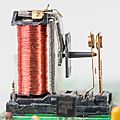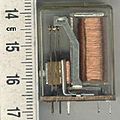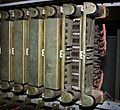Relay facts for kids
A relay is like a special kind of switch that uses a small amount of electricity to control a much larger amount. Imagine turning on a big machine with just a tiny button – a relay helps make that happen! It's an electromagnetic device, meaning it uses magnetism created by electricity to open or close a circuit.
Contents
What is a Relay?
Relays were first invented in the 1800s to help send telegraph signals over very long distances. Think of them as signal boosters! Today, relays are super useful for controlling circuits that use low voltages, like the ones in your car or many electronic gadgets. They act as a bridge, letting a small electrical signal switch on or off a more powerful electrical path.
How Does a Relay Work?
A basic relay has a few main parts:
- An electromagnet: This is a coil of wire that becomes a magnet when electricity flows through it.
- An armature: This is a movable metal part that the electromagnet can pull.
- Contacts: These are the parts that touch each other to complete an electrical circuit, or move apart to break it.
Here's how it works:
- When a small electric current flows into the relay's coil, it creates a magnetic field.
- This magnetic field pulls the armature, which then moves the contacts.
- The moving contacts either close a circuit (turning something on) or open a circuit (turning something off).
- When the small current stops, the magnetic field disappears, and a spring pulls the armature back to its original position, changing the state of the contacts again.
Why Do We Use Relays?
Relays are very useful for several reasons:
- Controlling high power with low power: You can use a small, safe switch to control a much larger, more powerful electrical device, like a car's starter motor.
- Safety: They can keep the low-voltage control circuit separate from the high-voltage power circuit, making things safer.
- Remote control: Relays allow you to switch things on or off from a distance.
- Automation: They are key parts of automatic systems, letting machines make decisions and control other machines.
Different Kinds of Relays
There are many types of relays, each designed for different jobs:
- Electromechanical relays: These are the most common type, using the moving parts described above.
- Solid-state relays: These relays have no moving parts! They use electronic components to switch circuits on and off. They are very fast and last a long time because there's no wear and tear from movement.
- Latching relays: These relays stay in their last position (on or off) even after the control power is removed. They need another pulse of electricity to change their state.
- Reed relays: These are very small relays where the contacts are sealed inside a glass tube, protecting them from dirt and dust.
Relays are found in many places, from your home appliances and cars to big industrial machines and telephone systems. They are a simple but very important invention that helps make our modern world work!
Images for kids
See also
 In Spanish: Relé para niños
In Spanish: Relé para niños















